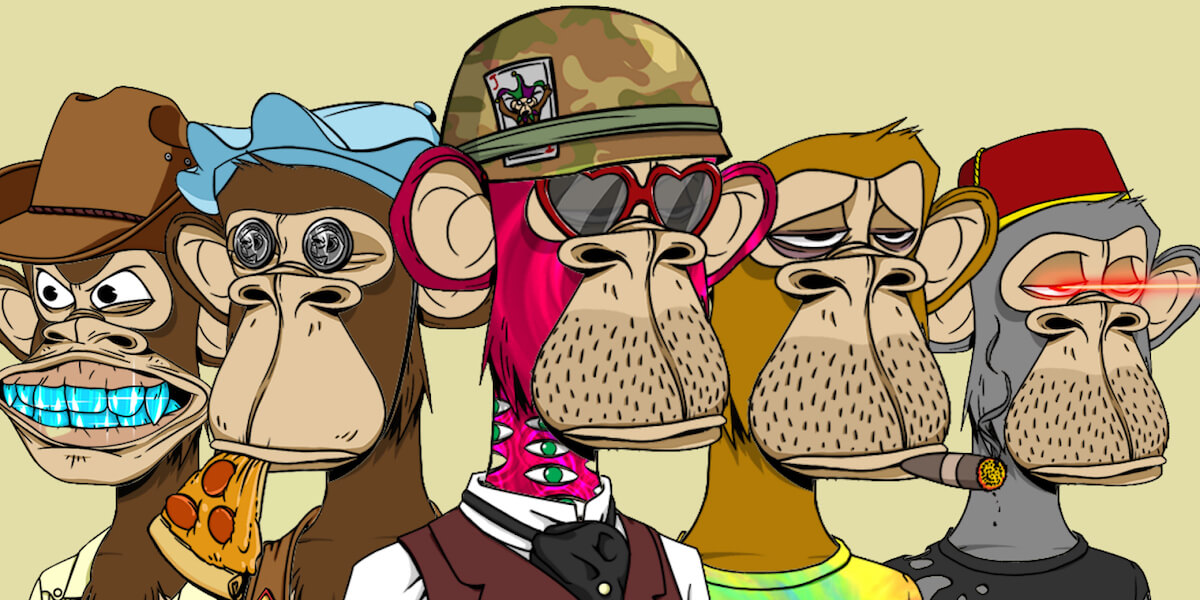A group of USC students has come together to form Moonlight, a crowdfunding platform where people can split the cost of a non-fungible token.
Bored Ape Yacht Club NFTs have exploded in popularity and fetched millions. (Courtesy/WTF)
Blake Asherian, a senior at USC Marshall School of Business, was fascinated by the Bored Ape Yacht Club collection.
The “Apes,” a collection of meme-worthy, internet cartoon primates have become some of the most coveted NFTs, or non-fungible tokens — unique, digital items like pictures, videos, songs and even brain scans that people can buy or sell. Recently, 101 NFTs of the cartoon apes sold for $24 million at Sotheby’s, according to Forbes.
Unable to purchase one of the NFTs himself last year, as many cost tens of thousands of dollars, Asherian texted his housemates to see if they would be willing to split the cost of one. A text message chain that was usually dormant replied instantly, as Asherian’s housemates jumped at the opportunity.
“There’s something here,” Asherian said. “I looked at the marketplaces that are currently doing it, and it really turned me off from the idea because the platforms were very confusing, and they just really didn’t make sense.”
However, the interest that his housemates showed in jointly purchasing an NFT together inspired Asherian to get at the forefront of this unique market. Ultimately, he decided to create Moonlight, a platform that would be simpler and more accessible than the marketplaces that kept Asherian and his housemates from collectively owning an NFT.
After a semester abroad in France, Asherian returned to Los Angeles this past summer ready to take on this new idea and met USC senior Gabriel Perez and USC graduate Matthew Hausman. Perez studies economics and minors in blockchain, a perfect combination to take on this exciting project. His own interest in NFTs and experience in trading them as well as his involvement in the USC Blockchain Club prepared him to take his expertise on the topic to the next level with the new company Moonlight.
Moonlight is a decentralized platform, meaning that no larger entity has control over the transactions and users can see exactly where their own assets go.
“What Moonlight allows users to do is to own ‘fractions’ of these assets. It opens up extremely in-demand items to the concept of collective ownership on the blockchain,” Perez said. “Moonlight would allow hundreds of different people to basically split the cost or own a piece of the artwork. This means that they would be able to display it and provide proof of authenticity on the blockchain.”
In a similar vein, not all investors can afford a piece of Warren Buffet’s company, Berkshire Hathaway. Instead, they can buy fractional shares, literally a percentage of the stock. In the case of Moonlight, investors could, in theory, buy a small piece of internet art or a LeBron James slam dunk.
Moonlight seeks to democratize the ownership of NFTs, as their high prices keep the average person from participating. Many do not understand what the value of owning an NFT is, as unlike a tangible piece of art, it can only be displayed electronically. However, the Moonlight team sees a more complex future for NFTs. For example, when Asherian posted one of his NFTs on Twitter, he immediately attracted a community.
Many people understand NFTs to simply be a way to show off their assets, but Asherian views them differently. “NFTs can serve not just as a picture, but as a pass, a membership, a one-of-one,” said Asherian. “This is a way of owning something socially and a lot of what NFTs stand for is community.”
Matthew Hausman, a computer science and business administration graduate from USC Viterbi School of Engineering and the FrontEnd architect for Moonlight, meaning his role is to work on the visual part of the website. “I hope that we make collecting NFT fractions the de facto way to have exposure to NFTs for collectors with less money to dedicate to speculative bets,” Hausman said
Since cryptocurrency and decentralization have such a strong future ahead of them and represent collectiveness, said Asherian. According to the team, Moonlight’s ultimate goal is to lower barrier of entry for all to participate, the team is striving for ways to innovate this year; for example, the team hopes to allow people who do not own cryptocurrency to purchase NFTs using credit cards, and digital wallets connected to their social media accounts.
USC has fostered the connection between the collaborators in Moonlight, while also giving them a strong network for the future of the product.
“[USC] has prepared me more than you know. It’s the Trojan Network,” Asherian said.
Published on October 5th, 2022
Last updated on October 5th, 2022
Share This Story
Share this Post Visit UsContact Us
Visit UsContact Us

